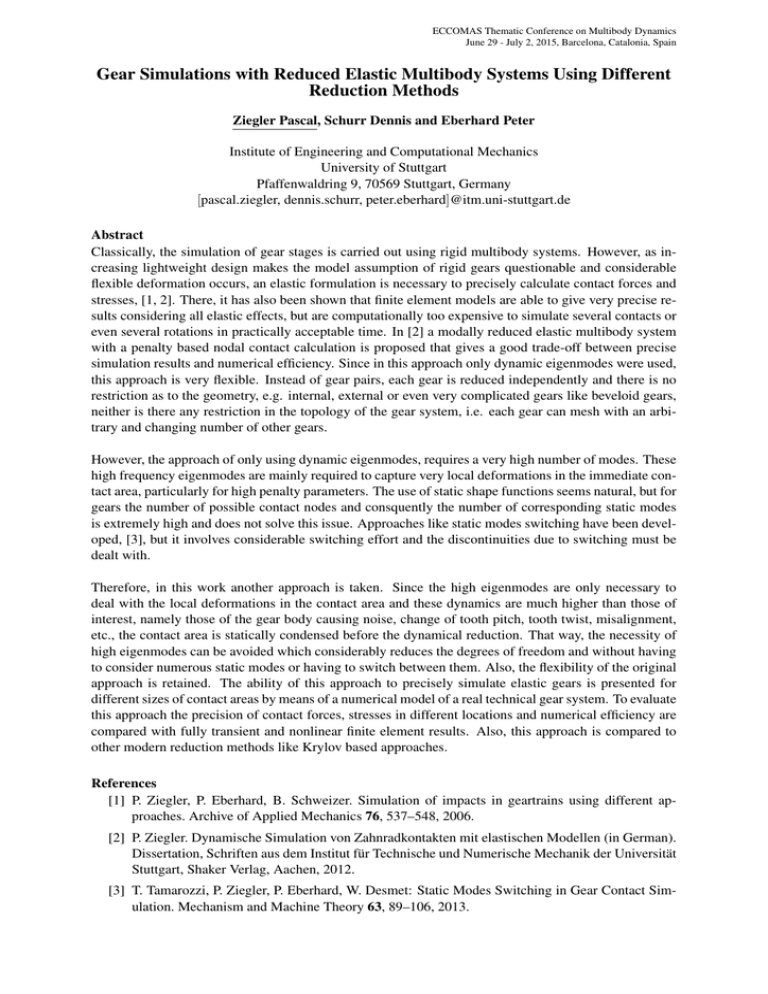Gear Simulations with Reduced Elastic Multibody Systems Using
advertisement

ECCOMAS Thematic Conference on Multibody Dynamics June 29 - July 2, 2015, Barcelona, Catalonia, Spain Gear Simulations with Reduced Elastic Multibody Systems Using Different Reduction Methods Ziegler Pascal, Schurr Dennis and Eberhard Peter Institute of Engineering and Computational Mechanics University of Stuttgart Pfaffenwaldring 9, 70569 Stuttgart, Germany [pascal.ziegler, dennis.schurr, peter.eberhard]@itm.uni-stuttgart.de Abstract Classically, the simulation of gear stages is carried out using rigid multibody systems. However, as increasing lightweight design makes the model assumption of rigid gears questionable and considerable flexible deformation occurs, an elastic formulation is necessary to precisely calculate contact forces and stresses, [1, 2]. There, it has also been shown that finite element models are able to give very precise results considering all elastic effects, but are computationally too expensive to simulate several contacts or even several rotations in practically acceptable time. In [2] a modally reduced elastic multibody system with a penalty based nodal contact calculation is proposed that gives a good trade-off between precise simulation results and numerical efficiency. Since in this approach only dynamic eigenmodes were used, this approach is very flexible. Instead of gear pairs, each gear is reduced independently and there is no restriction as to the geometry, e.g. internal, external or even very complicated gears like beveloid gears, neither is there any restriction in the topology of the gear system, i.e. each gear can mesh with an arbitrary and changing number of other gears. However, the approach of only using dynamic eigenmodes, requires a very high number of modes. These high frequency eigenmodes are mainly required to capture very local deformations in the immediate contact area, particularly for high penalty parameters. The use of static shape functions seems natural, but for gears the number of possible contact nodes and consquently the number of corresponding static modes is extremely high and does not solve this issue. Approaches like static modes switching have been developed, [3], but it involves considerable switching effort and the discontinuities due to switching must be dealt with. Therefore, in this work another approach is taken. Since the high eigenmodes are only necessary to deal with the local deformations in the contact area and these dynamics are much higher than those of interest, namely those of the gear body causing noise, change of tooth pitch, tooth twist, misalignment, etc., the contact area is statically condensed before the dynamical reduction. That way, the necessity of high eigenmodes can be avoided which considerably reduces the degrees of freedom and without having to consider numerous static modes or having to switch between them. Also, the flexibility of the original approach is retained. The ability of this approach to precisely simulate elastic gears is presented for different sizes of contact areas by means of a numerical model of a real technical gear system. To evaluate this approach the precision of contact forces, stresses in different locations and numerical efficiency are compared with fully transient and nonlinear finite element results. Also, this approach is compared to other modern reduction methods like Krylov based approaches. References [1] P. Ziegler, P. Eberhard, B. Schweizer. Simulation of impacts in geartrains using different approaches. Archive of Applied Mechanics 76, 537–548, 2006. [2] P. Ziegler. Dynamische Simulation von Zahnradkontakten mit elastischen Modellen (in German). Dissertation, Schriften aus dem Institut für Technische und Numerische Mechanik der Universität Stuttgart, Shaker Verlag, Aachen, 2012. [3] T. Tamarozzi, P. Ziegler, P. Eberhard, W. Desmet: Static Modes Switching in Gear Contact Simulation. Mechanism and Machine Theory 63, 89–106, 2013.

![Machine Elements [Opens in New Window]](http://s3.studylib.net/store/data/009054465_1-76bd66345967cd60934cd86eccae6fad-300x300.png)



